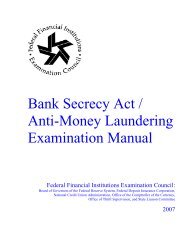A Guide to HMDA Reporting - ffiec
A Guide to HMDA Reporting - ffiec
A Guide to HMDA Reporting - ffiec
You also want an ePaper? Increase the reach of your titles
YUMPU automatically turns print PDFs into web optimized ePapers that Google loves.
Appendix D the institution reports using the<br />
Official Staff “Asian” code.<br />
Commentary on<br />
Regulation C 2. Applicant data—completion by<br />
Effective lender. If an applicant fails <strong>to</strong> pro-<br />
January 1, 2004 vide the requested information for<br />
an application taken in person, the<br />
institution reports the data on the<br />
basis of visual observation or<br />
surname.<br />
3. Applicant data—application completed<br />
in person. When an applicant<br />
meets in person with a lender <strong>to</strong><br />
complete an application that was<br />
begun by mail, Internet, or telephone,<br />
the institution must request<br />
the moni<strong>to</strong>ring information. If the<br />
meeting occurs after the application<br />
process is complete, for example, at<br />
closing, the institution is not required<br />
<strong>to</strong> obtain moni<strong>to</strong>ring information.<br />
4. Applicant data—joint applicant. A<br />
joint applicant may enter the government<br />
moni<strong>to</strong>ring information on<br />
behalf of an absent joint applicant.<br />
If the information is not provided, the<br />
institution reports using the code for<br />
“information not provided by applicant<br />
in mail, Internet, or telephone<br />
application.”<br />
5. Applicant data—video and other<br />
electronic-application processes.<br />
An institution that accepts applications<br />
through electronic media with a<br />
video component treats the applications<br />
as taken in person and collects<br />
the information about the ethnicity,<br />
race, and sex of applicants. An<br />
institution that accepts applications<br />
through electronic media without a<br />
video component (for example, the<br />
Internet or facsimile) treats the<br />
applications as accepted by mail.<br />
6. Income data—income relied on. An<br />
institution reports the gross annual<br />
income relied on in evaluating the<br />
creditworthiness of applicants. For<br />
example, if an institution relies on an<br />
applicant’s salary <strong>to</strong> compute a<br />
debt-<strong>to</strong>-income ratio but also relies<br />
on the applicant’s annual bonus <strong>to</strong><br />
evaluate creditworthiness, the institution<br />
reports the salary and the<br />
bonus <strong>to</strong> the extent relied upon.<br />
Similarly, if an institution relies on<br />
the income of a cosigner <strong>to</strong> evaluate<br />
creditworthiness, the institution<br />
includes this income <strong>to</strong> the extent<br />
relied upon. But an institution does<br />
not include the income of a guaran<strong>to</strong>r<br />
who is only secondarily liable.<br />
7. Income data—co-applicant. If two<br />
persons jointly apply for a loan and<br />
both list income on the application,<br />
but the institution relies only on the<br />
income of one applicant in computing<br />
ratios and in evaluating creditworthiness,<br />
the institution reports<br />
only the income relied on.<br />
8. Income data—loan <strong>to</strong> employee.<br />
An institution may report “NA” in the<br />
income field for loans <strong>to</strong> its employees<br />
<strong>to</strong> protect their privacy, even<br />
though the institution relied on<br />
their income in making its credit<br />
decisions.<br />
4(a)(11) Purchaser.<br />
1. Type of purchaser—loan-participation<br />
interests sold <strong>to</strong> more than<br />
one entity. An institution that<br />
originates a loan, and then sells it <strong>to</strong><br />
more than one entity, reports the<br />
“type of purchaser” based on the<br />
entity purchasing the greatest<br />
interest, if any. If an institution<br />
retains a majority interest, it does<br />
not report the sale.<br />
2. Type of purchaser-swapped loans.<br />
Loans “swapped” for mortgage-<br />
D-13
















